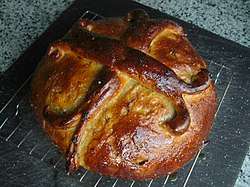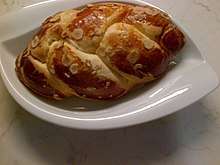Tsoureki
Tsoureki (Greek: τσουρέκι) is a sweet holiday bread made with flour, milk, butter and sugar and commonly seasoned with orange zest, mastic resin or mahlab. One variation commonly called "Easter bread" is made by Greek communities during Easter, not only in Greece, but also in other countries with Greek communities. It is also sometimes called Armenian Easter bread.[1]
 Christopsomo Christmas bread | |
| Type | Sweet bread |
|---|---|
| Place of origin | Armenia |
| Variations | Savoury versions |
It is eaten in Greece, Turkey, Armenia and other Middle-eastern countries.[2]
Etymology
The Greek word tsoureki is borrowed from Turkish çörek. Some dictionaries claim that this is derived from the Old Turkish root çevir- 'turn'; [3] others say it is Persian[4] or Armenian.
Greek tradition
There are different variations of the Greek tsoureki holiday breads including a round Christmas loaf with a cross decoration called Christopsomo, a braided easter bread with whole dyed eggs pressed into the dough called lampropsomo, and a loaf with a coin hidden inside for good luck called vasilopita that is baked for St. Basil's Day (New Year's Day).[5]
Easter bread
Tsoureki is a Greek holiday bread that is made by Greeks during Easter, not only in Greece, but also in other countries with Greek communities.[1] It is made from a sweet yeast dough of flour, sugar, butter and milk, with dyed red Easter eggs pressed into the dough. The dough is brushed with egg wash before baking, and sometimes flavored with mahlep, mastic resin or orange zest. Other flavorings might include almond extract, cinnamon, sultanas or fennel seed.[6][7][8][9]
This bread is sometimes called "Armenian Easter bread".[10] Traditional Armenian cheoreg omits the dyed Easter eggs and may be made in smaller sizes, dividing the dough into 10 or 12 portions rather than baking as one whole braided loaf.[11]
The Turkish language name for this bread is paskalya çöreği (paskalya is the Turkish word for Easter). Turkish recipes include egg in the dough, rather than pressed into the dough as decoration.[12][13] Some recipes substitute a neutral-flavored oil, such as sunflower oil, and margarine in place of milk and butter.[14] The dough may be seasoned with orange zest, vanilla, mahlep and slivered almonds.[15][16]
Sometime tsoureki is used as a gift for special occasion, for instance, it can be given as an Easter gift from children to their godparents.
Christmas bread
Christopsomo (Χριστόψωμο), which translates as "Christ's bread", is a traditional Greek holiday bread that is sometimes decorated with whole walnuts, sesame seeds and slivered almonds.[17] Also called Christmas fruit bread, the tsoureki dough may include a combination of raisins, dried apricots, dried figs, orange zest, cinnamon, allspice, cloves, cardamom, mastic resin and mahleb.[17][18][19] (Some recipes suggest marinating the raisins and dried figs overnight in wines like retsina or mavrodaphne).[20] Some of the dough is set aside for the loaf's cross-shaped decoration.[21]
The bread may be glazed with a syrup made from honey, orange juice and slivered almonds.[20]
New Year's bread
The traditional New Year's cake, Vasilopita (Βασιλόπιτα) is sometimes a tsoureki.
See also
References
- Davidson, Alan (1981-01-01). National & Regional Styles of Cookery: Proceedings : Oxford Symposium 1981. Oxford Symposium. ISBN 978-0-907325-07-9. Archived from the original on 2016-05-14. Retrieved 2018-07-22.
- 'Толковìй словарь живаго великорусскаго язîка, Dal' V.I., IAS, 1869
- "çörek". Etymological Dictionary of Contemporary Turkish. Archived from the original on 2017-12-01. Retrieved 2017-05-12.
- Dwight, Harry Griswold (1915). Constantinople, Old and New. Longmans, Green. p. 331. Retrieved 2017-05-12.
- The Oxford Companion to Sugar and Sweets. Oxford University Press. 2015-04-01. ISBN 978-0-19-931362-4.
- "Greek Easter Bread". Food Network. Archived from the original on 2018-03-23. Retrieved 2018-07-22.
- "Tsoureki (Greek Easter Bread)". Martha Stewart. 2013-02-28. Archived from the original on 2017-06-21. Retrieved 2018-07-22.
- "Tsoureki bread (Greek Easter bread)". BBC Food. Retrieved 2018-07-22.
- "Paul Hollywood's Tsoureki- Greek Easter Bread Recipe". PBS Food. 2018-03-12. Archived from the original on 2018-07-23. Retrieved 2018-07-22.
- Roufs, Timothy G.; Roufs, Kathleen Smyth (2014-07-29). Sweet Treats around the World: An Encyclopedia of Food and Culture: An Encyclopedia of Food and Culture. ABC-CLIO. ISBN 978-1-61069-221-2.
- "Chefs prepare Easter feasts with special dishes, breads". Archived from the original on 2018-01-02. Retrieved 2018-07-22.
- "Paskalya Çöreği tarifi… En lezzetli gerçek Paskalya Çöreği nasıl yapılır?". Archived from the original on 2018-04-01. Retrieved 2018-07-22.
- Soysal, Sahrap. "Mahlepli paskalya çöreği". Archived from the original on 2017-05-07. Retrieved 2018-07-22.
- "Paskalya çöreği tarifi - Hamurişi Haberleri". Archived from the original on 2016-08-14. Retrieved 2018-07-22.
- Arda'nın Mutfağıundefined (Director). Paskalya Çöreği - Arda’nın Mutfağı. Event occurs at 321 seconds. Archived from the original on 2018-07-23. Retrieved 2018-07-22.
- Nursel'in Evi. Paskalya Çöreği Tarifi. Archived from the original on 2018-07-23. Retrieved 2018-07-22.
- Kochilas, Diane (1993-03-15). The Food and Wine of Greece: More Than 250 Classic and Modern Dishes from the Mainland and Islands. Macmillan. ISBN 978-0-312-08783-8.
- Guinn, Jeff (2012). Santa's North Pole Cookbook: Classic Christmas Recipes from Saint Nicholas Himself. Jeremy P. Tarcher/Penguin. ISBN 978-0-399-16064-6.
- Hensperger, Beth (2000-04-30). Bread Lover's Bread Machine Cookbook: A Master Baker's 300 Favorite Recipes for Perfect-Every-Time Bread-From Every Kind of Machine. Harvard Common Press. ISBN 978-1-55832-156-4. Archived from the original on 2018-07-23. Retrieved 2018-07-22.
- Hoffman, Susanna (2004). The Olive and the Caper: Adventures in Greek Cooking. Workman Publishing. p. 142. ISBN 978-0-7611-3468-8.
- Pasteleria Artesana. Programa N° 53: 1 de diciembre 2012: Algunas Historias... Christopsomo. Retrieved 2018-07-22.
